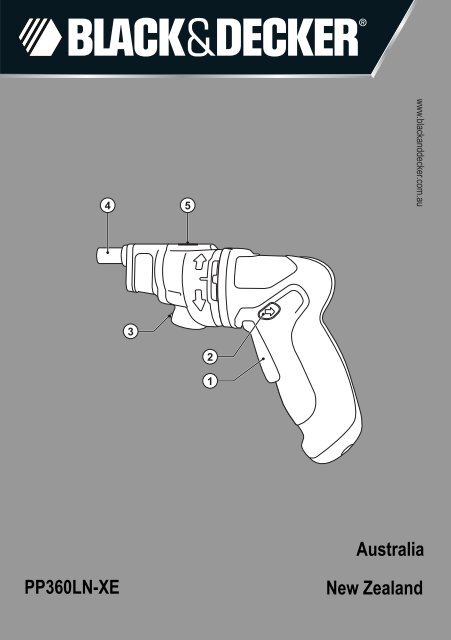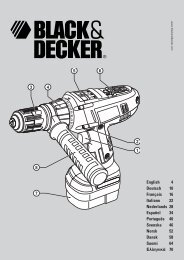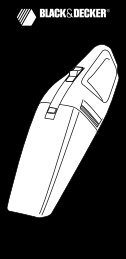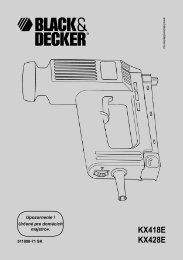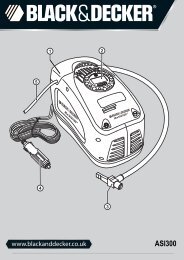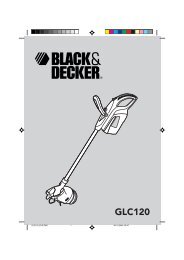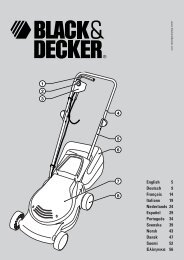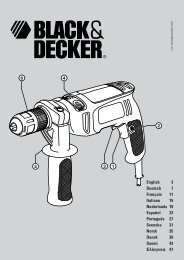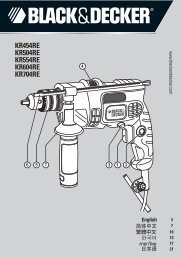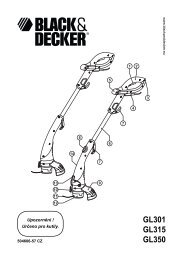PP360LN-XE Australia New Zealand - Black & Decker
PP360LN-XE Australia New Zealand - Black & Decker
PP360LN-XE Australia New Zealand - Black & Decker
Create successful ePaper yourself
Turn your PDF publications into a flip-book with our unique Google optimized e-Paper software.
Intended useYour <strong>Black</strong> & <strong>Decker</strong> Pivot Driver has been designed forscrewdriving applications. These applications include drivingscrews in tight locations, such as close to edges and cornersand against ceilings and floors, etc. This tool is intended forconsumer use only.Safety instructionsGeneral power tool safety warningsWarning! Read all safety warnings and allinstructions. Failure to follow the warnings andinstructions listed below may result in electric shock,fire and/or serious injury.Save all warnings and instructions for future reference.The term "power tool" in all of the warnings listed below refersto your mains operated (corded) power tool or batteryoperated (cordless) power tool.1. Work area safetya. Keep work area clean and well lit. Cluttered or darkareas invite accidents.b. Do not operate power tools in explosive atmospheres,such as in the presence of flammable liquids, gasesor dust. Power tools create sparks which may ignite thedust or fumes.c. Keep children and bystanders away while operatinga power tool. Distractions can cause you to lose control.2. Electrical safetya. Power tool plugs must match the outlet. Never modifythe plug in any way. Do not use any adapter plugswith earthed (grounded) power tools. Unmodified plugsand matching outlets will reduce risk of electric shock.b. Avoid body contact with earthed or groundedsurfaces such as pipes, radiators, ranges andrefrigerators. There is an increased risk of electric shockif your body is earthed or grounded.c. Do not expose power tools to rain or wet conditions.Water entering a power tool will increase the risk ofelectric shock.d. Do not abuse the cord. Never use the cord for carrying,pulling or unplugging the power tool. Keep cord awayfrom heat, oil, sharp edges or moving parts. Damagedor entangled cords increase the risk of electric shock.e. When operating a power tool outdoors, use anextension cord suitable for outdoor use. Use of a cordsuitable for outdoor use reduces the risk of electric shock.f. If operating a power tool in a damp location isunavoidable, use a residual current device (RCD)protected supply. Use of an RCD reduces the risk ofelectric shock.3. Personal safetya. Stay alert, watch what you are doing and use commonsense when operating a power tool. Do not use a powertool while you are tired or under the influence of drugs,alcohol or medication. A moment of inattention whileoperating power tools may result in serious personal injury.b. Use personal protective equipment. Always wear eyeprotection. Protective equipment such as dust mask,non-skid safety shoes, hard hat, or hearing protectionused for appropriate conditions will reduce personal injuries.c. Prevent unintentional starting. Ensure the switch is inthe off-position before connecting to power sourceand/or battery pack, picking up or carrying the tool.Carrying power tools with your finger on the switch orenergising power tools that have the switch on invitesaccidents.d. Remove any adjusting key or wrench before turningthe power tool on. A wrench or a key left attached to arotating part of the power tool may result in personal injury.e. Do not overreach. Keep proper footing and balance atall times. This enables better control of the power tool inunexpected situations.f. Dress properly. Do not wear loose clothing orjewellery. Keep your hair, clothing and gloves awayfrom moving parts. Loose clothes, jewellery or long haircan be caught in moving parts.g. If devices are provided for the connection of dustextraction and collection facilities, ensure these areconnected and properly used. Use of dust collection canreduce dust-related hazards.4. Power tool use and carea. Do not force the power tool. Use the correct powertool for your application. The correct power tool will dothe job better and safer at the rate for which it wasdesigned.b. Do not use the power tool if the switch does not turn iton and off. Any power tool that cannot be controlled withthe switch is dangerous and must be repaired.c. Disconnect the plug from the power source and/or thebattery pack from the power tool before making anyadjustments, changing accessories, or storing powertools. Such preventive safety measures reduce the risk ofstarting the power tool accidentally.d. Store idle power tools out of the reach of children anddo not allow persons unfamiliar with the power tool orthese instructions to operate the power tool. Powertools are dangerous in the hands of untrained users.3
e. Maintain power tools. Check for misalignment orbinding of moving parts, breakage of parts and anyother condition that may affect the power toolsoperation. If damaged, have the power tool repairedbefore use. Many accidents are caused by poorlymaintained power tools.f. Keep cutting tools sharp and clean. Properlymaintained cutting tools with sharp cutting edges are lesslikely to bind and are easier to control.g. Use the power tool, accessories and tool bits etc.,in accordance with these instructions, taking intoaccount the working conditions and the work to beperformed. Use of the power tool for operations differentfrom those intended could result in a hazardous situation.5. Battery tool use and carea. Recharge only with the charger specified by themanufacturer. A charger that is suitable for one type ofbattery pack may create a risk of fire when used withanother battery pack.b. Use power tools only with specifically designatedbattery packs. Use of any other battery packs may createa risk of injury and fire.c. When battery pack is not in use, keep it away fromother metal objects, like paper clips, coins, keys, nails,screws, or other small metal objects, that can make aconnection from one terminal to another. Shorting thebattery terminals together may cause burns or a fire.d. Under abusive conditions, liquid may be ejected fromthe battery; avoid contact. If contact accidentallyoccurs, flush with water. If liquid contacts eyes,additionally seek medical help. Liquid ejected from thebattery may cause irritation or burns.6. Servicea. Have your power tool serviced by a qualified repairperson using only identical replacement parts. This willensure that the safety of the power tool is maintained.Additional power tool safety warningsWarning! Additional safety warnings forscrewdrivers◆ Hold power tool by insulated gripping surfaces, whenperforming an operation where the fastener maycontact hidden wiring or its own cord. Fastenerscontacting a "live" wire may make exposed metal parts ofthe power tool "live" and could give the operator an electricshock.◆ Use clamps or another practical way to secure andsupport the workpiece to a stable platform. Holding thework by hand or against your body leaves it unstable andmay lead to loss of control.◆Before driving fasteners into walls, floors or ceilings,check for the location of wiring and pipes.◆ This tool is not intended for use by persons (includingchildren) with reduced physical, sensory or mentalcapabilities, or lack of experience and knowledge, unlessthey have been given supervision or instructionconcerning use of the appliance by a person responsiblefor their safety. Children should be supervised to ensurethat they do not play with the appliance.◆ The intended use is described in this instruction manual.The use of any accessory or attachment or performanceof any operation with this tool other than thoserecommended in this instruction manual may presenta risk of personal injury and/or damage to property.VibrationThe declared vibration emission values stated in the technicaldata and the declaration of conformity have been measured inaccordance with a standard test method provided byEN 60745 and may be used for comparing one tool withanother. The declared vibration emission value may also beused in a preliminary assessment of exposure.Warning! The vibration emission value during actual use ofthe power tool can differ from the declared value dependingon the ways in which the tool is used. The vibration level mayincrease above the level stated.When assessing vibration exposure to determine safetymeasures required by 2002/44/EC to protect persons regularlyusing power tools in employment, an estimation of vibrationexposure should consider, the actual conditions of use and theway the tool is used, including taking account of all parts ofthe operating cycle such as the times when the tool isswitched off and when it is running idle in addition to thetrigger time.Labels on toolThe following pictograms are shown on the tool:Warning! To reduce the risk of injury, the user mustread the instruction manual.4
Additional safety instructions for batteries andchargersBatteries◆ Never attempt to open for any reason.◆ Do not expose the battery to water.◆ Do not expose the battery to heat.◆ Do not store in locations where the temperature mayexceed 40 °C.◆ Charge only at ambient temperatures between 10 °C and40 °C.◆ Charge only using the charger provided with the tool.◆ When disposing of batteries, follow the instructions givenin the section "Protecting the environment".Chargers◆ Use your <strong>Black</strong> & <strong>Decker</strong> charger only to charge the batteryin the tool with which it was supplied. Other batteries couldburst, causing personal injury and damage.◆ Never attempt to charge non-rechargeable batteries.◆ Have defective cords replaced immediately.◆ Do not expose the charger to water.◆ Do not open the charger.◆ Do not probe the charger.The charger is intended for indoor use only.Read the instruction manual before use.Charge only at ambient temperatures between10 °C and 40 °C.ChargingElectrical safetyYour charger is double insulated; therefore no earthwire is required. Always check that the mainsvoltage corresponds to the voltage on the ratingplate. Never attempt to replace the charger unit witha regular mains plug.◆ If the supply cord is damaged, it must be replaced by themanufacturer or an authorised <strong>Black</strong> & <strong>Decker</strong> ServiceCentre in order to avoid a hazard.Overview1. On/off switch2. Forward/reverse slider3. LED light4. Bit holder5. Pivot release sliderFig. A6. Charger7. Charger plug8. Charger connectorAssemblyFitting and removing a screwdriver bit (fig. B)This tool uses screwdriver bits with a 1/4" (6.35 mm)hexagonal shank.◆ To fit a bit, insert the bit shaft into the bit holder (4).◆ To remove a bit, pull the bit shaft out of the bit holder (4).Use◆ Before first use, the battery must be charged for 14 hours.◆ The battery needs to be charged before first use andwhenever it fails to produce sufficient power on jobs thatwere easily done before. When charging the battery forthe first time, or after a prolonged storage, it will onlyaccept an 80% charge. After several charges anddischarge cycles, the battery will attain full capacity.◆ Place the tool on the charging base whenever it is not in use.Charging the battery (fig. A)◆ To charge the battery, insert the charger plug (7) into theconnector (8).◆ Plug in the charger (6).◆ Leave the tool connected to the charger for 6 - 10 hours.The charger may hum and become warm while charging;this is normal and does not indicate a problem.Generally, a charging time of 6 hours will enable the tool tooperate at an effective power level for most tasks. However,further charging for up to 10 hours could significantly increasethe run time, depending on the battery and chargingconditions.Warning! Do not charge the battery at ambient temperaturesbelow 4 °C or above 40 °C.5
Selecting the direction of rotationFor tightening screws, use forward (clockwise) rotation.For loosening screws use reverse (counterclockwise) rotation.◆ To select forward rotation, push the forward/reverse slider(2) to the left.◆ To select reverse rotation, push the forward/reverse slider(2) to the right.◆ To lock the tool, set the forward/reverse button into thecentre position.Screwdriving◆ Select forward or reverse rotation using theforward/reverse slider (2).◆ To switch the tool on, press the on/off switch (1).◆ To switch the tool off, release the on/off switch (1).Spindle lockThis tool is fitted with a spindle lock so that it can be used as anormal screwdriver. Use the tool this way to loosen very tightscrews or to firmly tighten screws.Rotating the gearbox (fig. C, D & E)The tool is fitted with a rotating gearbox to facilitate variousscrewdriving applications, such as reaching screws in tightcorners and close to ceilings and floors. The bitholder can beset to a centre position and 3 off-centre positions: top, left andright. The gearbox and the spindle can be rotated to set thevarious bitholder positions.◆ To rotate the gearbox (9) push the pivot release slider (5)forward and turn the gearbox 90° to the left or to the right(fig. C & D). Note: The gearbox will only turn 90° left andright. Do not attempt to turn any further.◆ To rotate the spindle (10) push the pivot release slider (5)backward and turn the spindle head 180° left or right (fig. E).Warning! Ensure the gearbox and spindle are locked intoplace before use.LED lightThe LED light is activated automatically when the trigger isdepressed. The LED will illuminate when the trigger isdepressed and the forward/reverse slider (2) is in the lockedoff position (central position).Hints for optimum use◆ Let the tool work at its own pace. Do not overload.◆ Always use the correct type and size of screwdriver bit.◆ If screws are difficult to tighten, try applying a smallamount of washing liquid or soap as a lubricant.◆ Use the auto spindle lock to loosen very tight screws or tofirmly tighten screws.◆ Always hold the tool and screwdriver bit in a straight linewith the screw.◆ When screwing in wood, it is recommended to drill a pilothole with a depth equal to the length of the screw.A pilot hole guides the screw and prevents splintering ordistortion of the wood. For the optimum size of the pilothole, refer to the table below.◆ When screwing in hardwood, also drill a clearance holewith a depth equal to half the length of the screw.For the optimum size of the clearance hole, refer to thetable below.Screw size Pilot hole ø Pilot hole ø Clearance(softwood) (hardwood) holeNo. 6 (3.5 mm) 2.0 mm 2.5 mm 4 mmNo. 8 (4 mm) 3.2 mm 3.5 mm 5.0 mmNo. 10 (5 mm) 3.5 mm 4.0 mm 5.7 mmAccessoriesThe performance of your tool depends on the accessory used.<strong>Black</strong> & <strong>Decker</strong> and Piranha accessories are engineered tohigh quality standards and designed to enhance theperformance of your tool. By using these accessories you willget the very best from your tool.This tool uses screwdriver bits with a 1/4" (6.35 mm)hexagonal shank.MaintenanceYour <strong>Black</strong> & <strong>Decker</strong> tool has been designed to operate over along period of time with a minimum of maintenance.Continuous satisfactory operation depends upon proper toolcare and regular cleaning.Your charger does not require any maintenance apart fromregular cleaning.Warning! Before performing any maintenance on the tool,remove the battery from the tool. Unplug the charger beforecleaning it.◆ Regularly clean the ventilation slots in your tool andcharger using a soft brush or dry cloth.◆ Regularly clean the motor housing using a damp cloth.Do not use any abrasive or solvent-based cleaner.Protecting the environmentSeparate collection. This product must not bedisposed of with normal household waste.Should you find one day that your <strong>Black</strong> & <strong>Decker</strong> productneeds replacement, or if it is of no further use to you, do notdispose of it with household waste. Make this productavailable for separate collection.6
PP360-<strong>XE</strong> - <strong>PP360LN</strong>-<strong>XE</strong> 1TYP.13PP360-<strong>XE</strong>2E15086www.2helpU.com 28 - 01 - 088
<strong>Australia</strong> & <strong>New</strong> <strong>Zealand</strong>Stanley <strong>Black</strong> & <strong>Decker</strong>82 Taryn Drive, Epping, VIC 3076 <strong>Australia</strong>Tel.1800 444 224 (Aust) or Tel. 0800 339 258 (NZ)90565066 RE08/12


